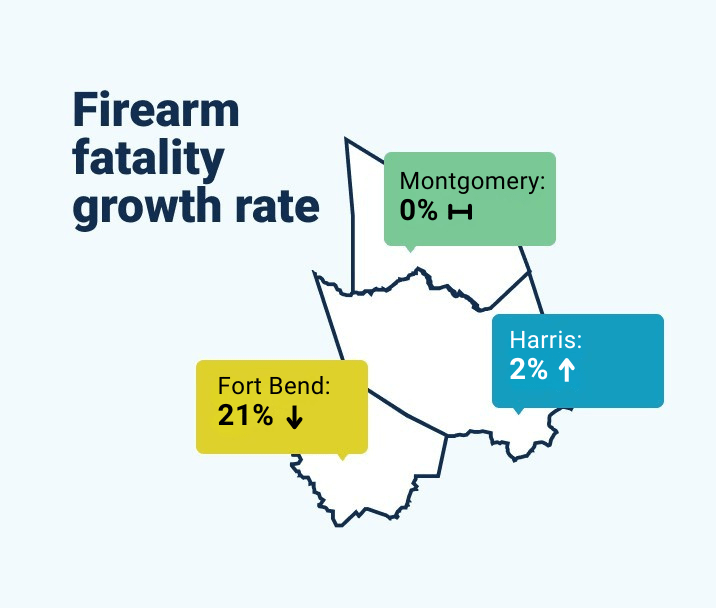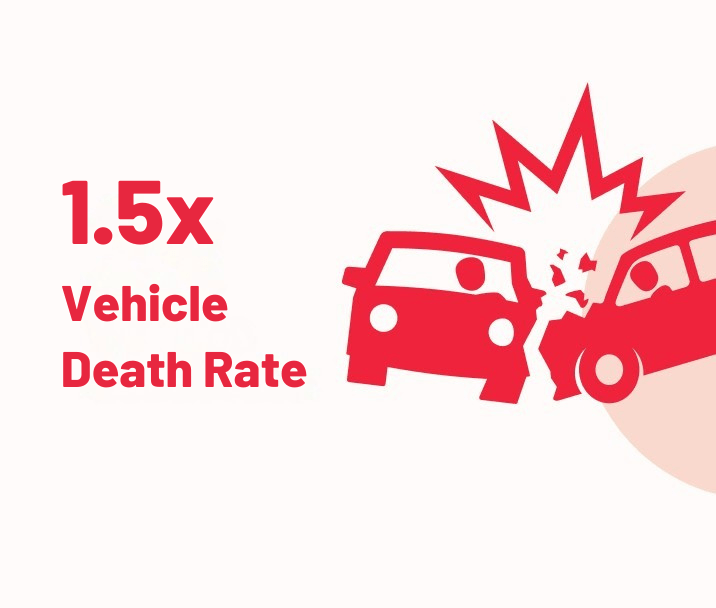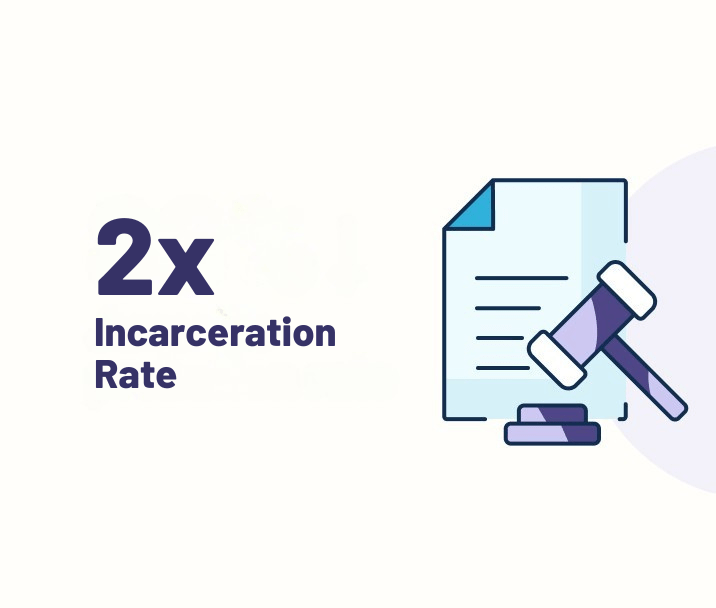Public Safety & Criminal Justice in Houston
Public safety is foundational to building a healthy environment that allows a community to thrive.
Gun death rates in the Houston region continue to increase, except in Fort Bend County, and while traffic-related deaths have fallen since 2000 they have begun to increase in recent years in Fort Bend and Harris counties. The number of reported hate crimes in the region has decreased since 2021 while reported human trafficking cases have increased slightly in recent years. And while adult incarceration rates have fallen, the rate at which juveniles are referred to probation has risen.

Between 2020 and 2023, Fort Bend County’s firearm fatality rate fell 21%, compared to no change in Montgomery County, a 2% rise in Harris County and nationally, and a 5% increase statewide.

Vehicle death rates in Harris and Montgomery counties (13 per 100,000) are more than 1.5 times as high as Fort Bend’s (8 per 100,000).

Harris and Montgomery counties had incarceration rates more than double the national rate as of 2020 (most recent data available).
Why Public Safety & Criminal Justice matter to Houston
The feeling of being safe is a foundational need for each of us. When we do not feel safe, it is difficult to focus on much else. Public safety is the backbone of society; without a sense of security, people are unable to freely and fairly pursue their goals, communities suffer from disinvestment and population loss, and the threads of social connectivity frays as we live in fear of and suspicion toward our neighbors. Currently, we establish public safety using the criminal and legal system — but that system itself can threaten the safety of our communities when it allows for unjust outcomes. All Houstonians want to be and feel safe in this region we call home, which is why we’re exploring multiple aspects of public safety: gun deaths, traffic deaths, crime, and incarceration rates.
The more we understand what is currently threatening public safety, the more effective our actions will be to protect the security of all Houstonians.
The data
Gun deaths rise in last decade
For four consecutive years, between 2020 and 2023, the top cause of death for American children was related to firearms. Of children who died in 2023, 16% of those deaths were a result of a gunshot wound. The number of people, especially children, who die as a result of a firearm is a public health threat — in 2023, that totaled nearly 2,600 children.
Firearms are involved in most killings in the United States, including 79% of all homicides and 55% of all suicides in 2023, according to the Centers for Disease Control and Prevention (CDC).
In 2023, the firearm fatality rate in Harris County was the highest in the Houston region at 16.4 deaths from firearms per 100,000 people. The firearm fatality rate in Fort Bend County was the lowest in the region at 8.5 per 100,000. Fort Bend County has boasted the lowest gun death rate consistently since 2000.
Gun violence is rising at the state and national level as well. Since 2010, the firearm fatality rate increased 35.7% across the country, 37.5% statewide and 30.6% within Houston’s three-county region. In Montgomery and Harris counties, the firearm fatality rate increased 38.1% and 34.6% from 2010 to 2023, respectively. In Fort Bend County, the firearm fatality rate increased 10.7% in the past decade, slower than the national pace.
Traffic deaths fall by nearly half in Montgomery and Fort Bend counties
Motor vehicle crashes were the second leading cause of death for Americans under the age of 25, behind firearm fatalities. According to estimates from the CDC, over 43,000 Americans lost their lives in motor vehicle traffic crashes in 2023. The human toll is devastating, but the economic impact is also costly. TRIP, a national transportation research nonprofit, estimates that the total social cost of these crashes — which accounts for the economic costs of fatalities, injuries, and vehicle damage — was $460 billion in 2023 alone.1
Historically, traffic death rates across the Houston region, Texas, and the United States declined over the past two decades. From 2000 to 2023, Montgomery County cut its vehicle death rate by more than half, while Fort Bend County saw a decline of 40%, compared to the statewide decline of 20% and 10% in Harris County and the nation. This decrease is part of a trend dating back to the mid-20th century attributable to advancements in car safety, increased seatbelt usage, and a successful campaign against drunk driving.2
However, it is crucial to note that the decline in traffic fatalities has slowed down or, in some cases, even reversed in the 2010-2020 period. During this time, Montgomery County continued to experience a decrease in the rate of vehicular collision deaths. However, rates started increasing in Harris County by 2015, following statewide and national trends, and increased in Fort Bend County between 2020 and 2023. Scholars point to increased distracted driving and the prevalence of cell phone usage while driving as contributors to this concerning trend. Despite these increases, Houston’s three-county area still has a below average rate of traffic fatalities compared to the statewide and national averages.
In 2023, Harris County recorded 635 traffic deaths, equivalent to around 1.7 deaths every day. This translates to a traffic death rate of 13.1 per 100,000 population in Harris County. In the United States and Texas, the figures are 14.3 and 15.4, respectively, meaning that Harris County has relatively less traffic fatalities than the nation despite being less walkable and more car dependent. The traffic death rate In Fort Bend County (8.3 deaths per 100,000) was less than that of Montgomery County (12.8 deaths per 100,000).
The number of reported hate crimes decreased in Houston and across Texas after 2021
A hate crime is a committed criminal offense that is motivated entirely or partly by the offender’s bias against a race, ethnicity, religion, sexual orientation, disability, gender or gender identity.
It is widely known that hate crimes are vastly underreported. In 2023, there were nearly 12,500 hate crime incidents reported by the U.S. Department of Justice. However, a study by the Bureau of Justic Statistics estimates that about 250,000 hate crimes occurred each year between 2005 and 2019.3 Historically, hate crimes have been chronically underreported because victims may not trust the authorities, experience language barriers, and find the reporting process difficult.4 And while the number of reported hate crimes declined across Houston and Texas since 2021, they continue to rise across the country.
Over time, the number of hate crimes reported to Houston Police Department (HPD) has generally increased. The number of reported hate crimes in 2020 exceeded the decade’s previous peak in 2015 and the number of reported crimes in 2021 exceeded those in 2022. While the numbers fell in 2022 and 2023, they are still higher than in the early 2010s. Historically, the majority of reported hate crimes are motivated by the victim’s race, ancestry, or ethnicity. However, for the first time in 2023, hate crimes motivated by the victim’s sexual orientation took up the largest proportion of hate crimes reported.
Across Texas and the United States, crimes motivated by race, ancestry, or ethnicity make up over half of all hate crimes reported. However, nationally, in the past decade since 2013, the number of hate crimes motivated by gender identity increased by over 1,500% and those motivated by gender increased by over 500%. The number of reported hate crimes motivated by race, ancestry, or ethnicity in the Lone Star State jumped from 88 in 2013 to 286 in 2023, increasing more than threefold while the number of similarly motivated hate crimes reported in Houston has nearly doubled during the same period.
Human trafficking rates in Texas continue to decline
Often described as modern-day slavery, human trafficking involves the use of force, intimidation, coercion, fraud or threats to exploit vulnerable individuals, including men, women, and children. While human trafficking takes various forms, sex trafficking and forced labor are the most common. Sex trafficking occurs when individuals use forms of coercion and intimidation to sexually exploit others and labor trafficking occurs when contractors, employers and others use forms of coercion to force people to work against their will. Because of its proximity to the U.S.-Mexico border and its central position relative to major cities on the East and West Coasts, Houston is known as a hub for human trafficking.
Human trafficking data, from the National Human Trafficking Hotline statistics, paint a picture of statewide and national trends. Note that these statistics only reflect calls to the hotline, and not criminal charges.
In Texas, 890 cases of human trafficking were reported to the hotline in 2023. This represents a significant increase from just eight years earlier when 450 cases were reported. This surge in reported trafficking cases was observed for both trafficked children and adults, although the overall number of adult cases reported to the hotline was higher. Over this period from 2015 to 2023, the number of human trafficking cases reported nearly doubled, however, they are still slightly below the peak in 2019 when 940 cases were reported to the hotline.
In 2023, the rate of human trafficking cases in Texas reported to the National Human Trafficking Hotline (2.95 cases per 100,000 population) was only slightly higher than in the U.S. (2.87). In both Texas and the U.S., the rate of trafficking peaked in 2019 and continued to decline through 2022. Across Texas, rates continued to decrease but saw a slight uptick nationally.
The incarceration rate in Harris County is more than double the national rate
The incarceration rate measures the rate of people in federal/state prisons and/or local jails per 100,000 residents. The Vera Institute of Justice compiles data from the Bureau of Justice Statistics to calculate the “total incarceration rate,” which accounts for both the state prison population and the county jail population, the latter of which is less typically included in measurements of incarceration.
In 2005, Harris County’s peak incarceration rate for ages 15-64 was nearly 1,600 per 100,000, triple Fort Bend’s rate, double Montgomery’s and the national rate, and slightly above Texas. By 2020, Harris County’s rate dropped 40% to 947 (below Texas’s 983 but over double the national 404). Meanwhile, Montgomery County’s rate stagnated, rising from parity with the US in 2000/2005 to 875 in 2020 (over double the national 404). Fort Bend County consistently had the lowest rate, at 355 in 2020, below the national average.
Across Houston’s three county region, there are pronounced disparities in the incarceration rates of different racial/ethnic groups.5 In the past decade, Black people are incarcerated at consistently the highest rates, reflecting — according to scholarly consensus — years of War on Drugs discriminatory policing and a legacy of economic exploitation and abandonment. In Harris County, the incarceration rate of Black adults in local jails is double that of white adults. In Fort Bend and Montgomery counties, Black people are 3.7 and 2.7 times more likely to be imprisoned, respectively.
Harris County’s juvenile probation referral rate rises after 2021
The juvenile detention system in Texas is a dedicated system focused on the “treatment and rehabilitation” of youth at least 10 years old but not yet 17 and are meant to be “protective, not punitive.” In lieu of being charged for a crime like adults, juveniles are “referred” to the court, which can then decide whether or not to place the minor on probation, pursue incarceration by charging the minor as an adult, or some other repercussion.
The juvenile probation referral rate, which adjusts for population changes over time, began increasing in 2022 after two years of declines. The Harris County Juvenile Probation Department expected this increase in the aftermath of the pandemic and predicted that numbers would eventually return to pre-pandemic levels. In 2023, just over 1,000 per 100,000 young people received referrals, which is almost on par with the rate of referrals in 2019 (1,160 per 100,000 people aged 10 to 17). Despite this recent uptick, referral rates in Harris County are still 71% lower than they were in 2010.
Additionally, the rate of referrals diverted from the juvenile justice system has increased in recent years. These diversion programs, designed for youth involved in lower-level offenses, offer a constructive alternate to detention and minimize these youths’ exposure to the criminal justice system,
This general decline in referrals since 2010 applies to all examined racial/ethnic groups, although there was a recent uptick for Black and white juveniles between 2021 and 2023. Additionally, racial/ethnic disparities persist. In 2021 and 2023, Black juveniles in Harris County were referred to probation at rates roughly four times higher than Hispanic youth and seven times higher than white youth.
Local policy experts attribute the overall decline in referrals to the successful implementation of innovative programs within the county.6 These programs, which include mental health services and drug diversion initiatives, are designed to redirect young individuals away from the juvenile justice system.
References:
- TRIP. (2024, July). Addressing America’s Traffic Safety Crisis: Examining the Causes of Increasing U.S. Traffic Fatalities and Identifying Solutions to Improve Traffic Safety TRIP. Retrieved from https://tripnet.org/wp-content/uploads/2024/07/TRIP_Addressing_Americas_Traffic_Safety_Crisis_Report_July_2024.pdf
- Cummings P, Rivara FP, Olson CM, et alChanges in traffic crash mortality rates attributed to use of alcohol, or lack of a seat belt, air bag, motorcycle helmet, or bicycle helmet, United States, 1982–2001. Injury Prevention 2006;12:148-154.
- Grace Kena; Alexandra Thompson, J.D., “Hate Crime Victimization, 2005-2019,” September 2021, bjs.ojp.gov: https://bjs.ojp.gov/sites/g/files/xyckuh236/files/media/document/hcv0519_1.pdf
- Culotta, K. A. (2005). Why victims hate to report: Factors affecting victim reporting in hate crime cases in Chicago. Kriminologija i Socijalna Integracija, 13, 15.
- Note about the data: Bureau of Justice Statistics data as compiled by the Vera Institute use race/ethnicity data as reported by prison staff, which can be inaccurate. Per the Vera Institute: “Although Latino people are overrepresented in jails and prisons nationally, common misclassification leads to distorted, lower estimates of Latino incarceration rates and distorted, higher estimates of white incarceration rates.” Source: “Texas.” https://trends.vera.org/state/TX. Access 28 Feb 2023.
- Texas Policy Lab. Historical Analysis of Lifetime Justice Involvement of Harris County Youth. 2023. Texas Policy Lab at Rice University, https://tplreports.rice.edu/shiny/HCJPD-longitudinal-analysis/.
